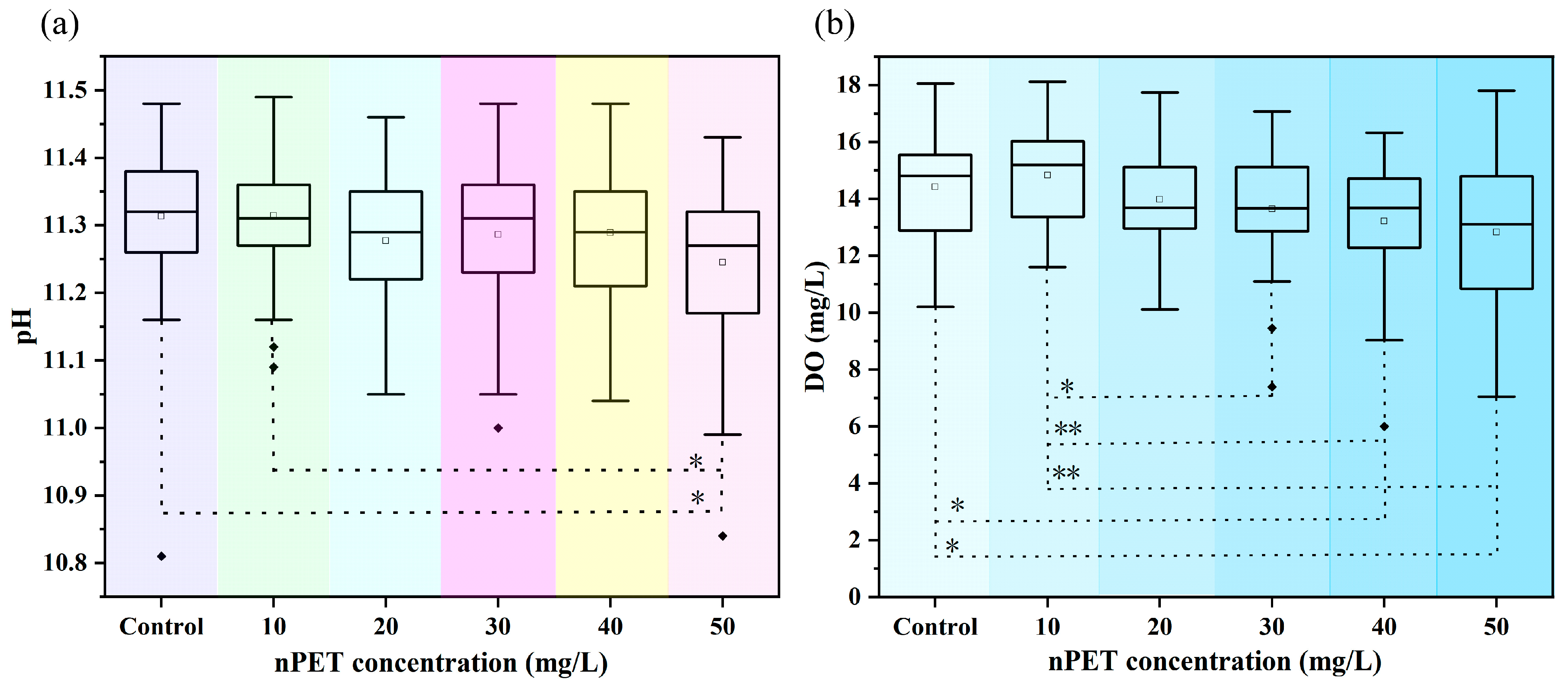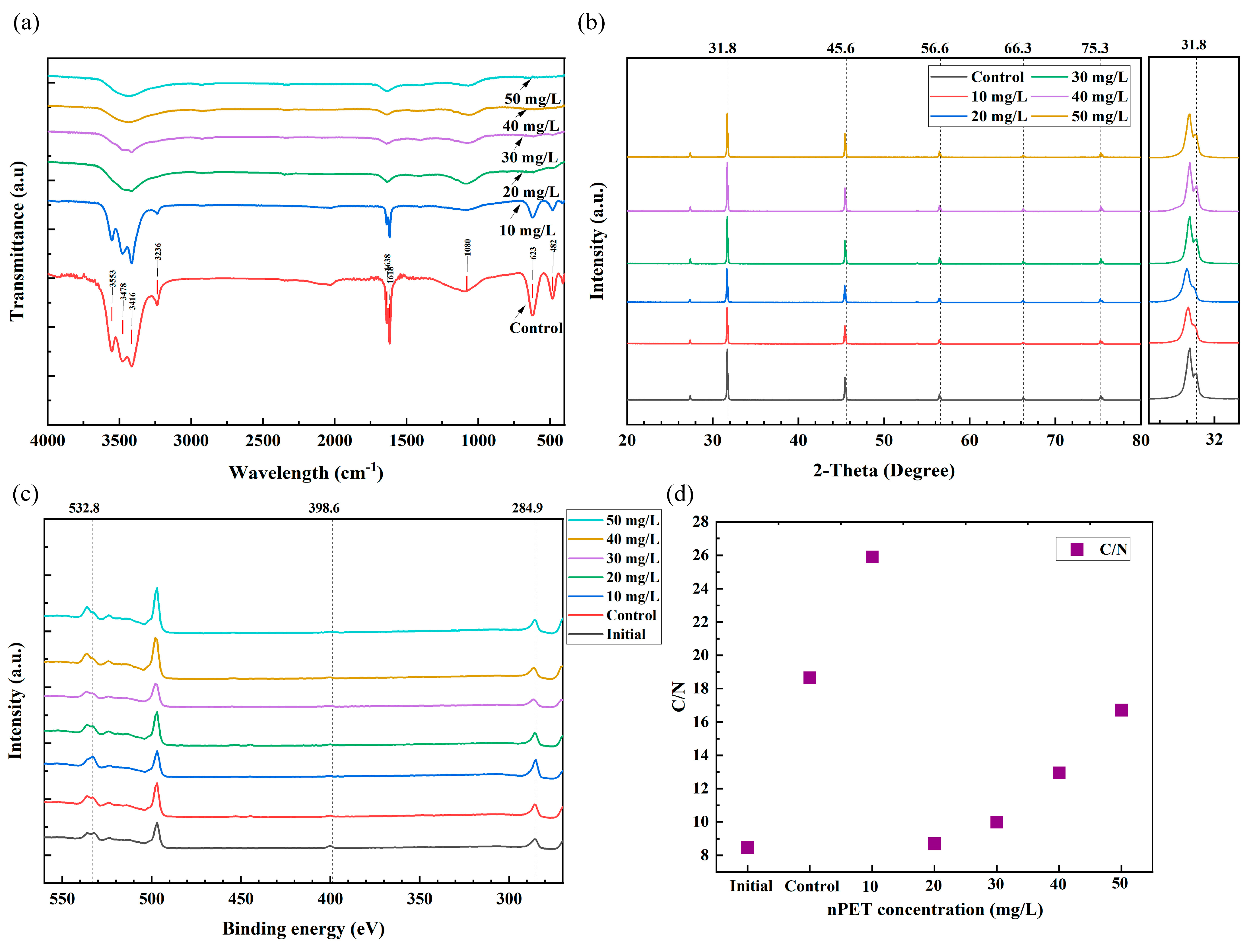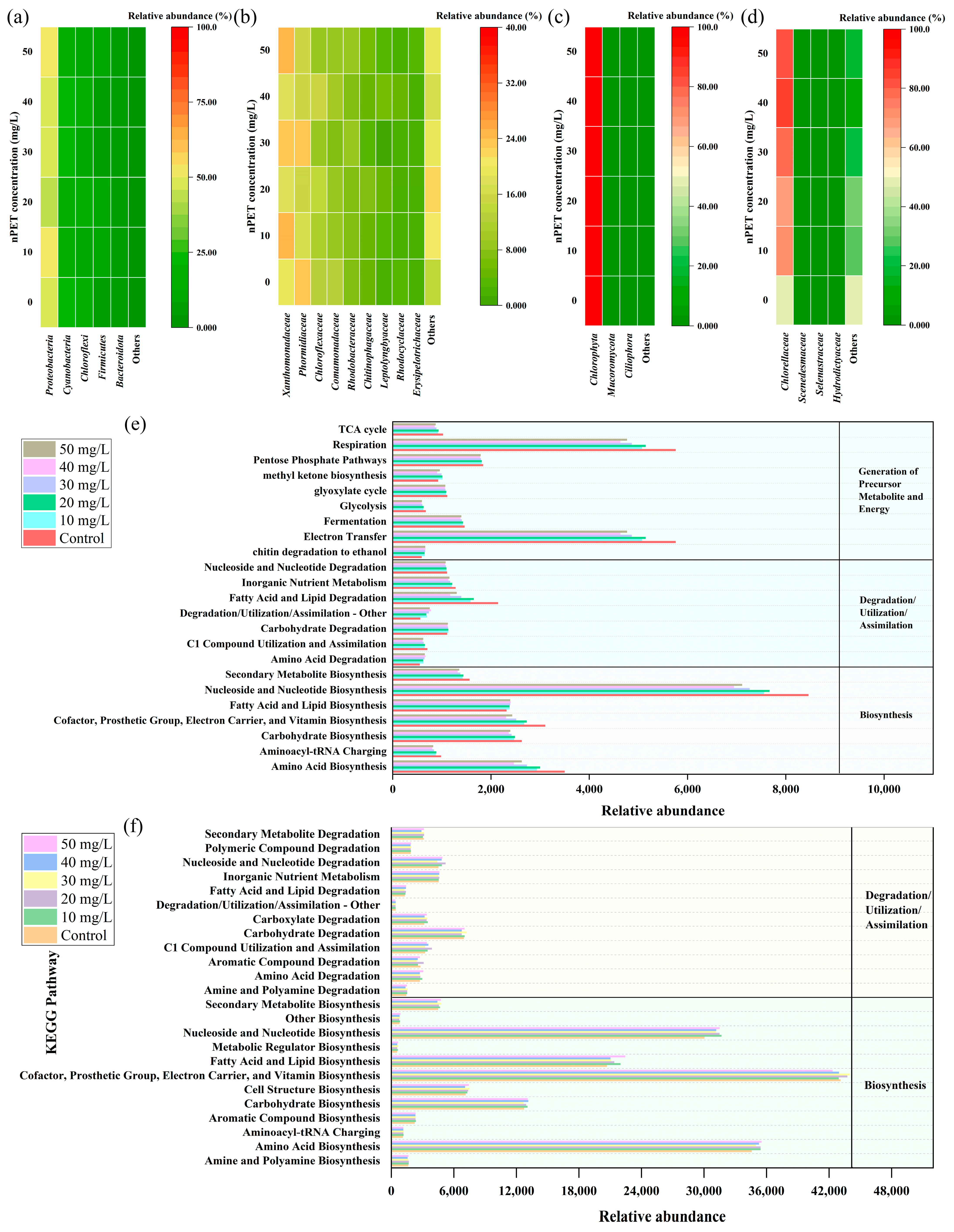Impact of Nano–Sized Polyethylene Terephthalate on Microalgal–Bacterial Granular Sludge in Non–Aerated Wastewater Treatment
Abstract
:1. Introduction
2. Materials and Methods
2.1. Compositions of Synthetic Wastewater
2.2. Experimental Setup
2.3. Analytical Methods
3. Results and Discussion
3.1. Pollutant Removal from nPET–Containing Wastewater
3.2. Granule Size and Morphology
3.3. EPS Spectral Analysis
3.4. Microbial Community Analysis
4. Conclusions
Author Contributions
Funding
Data Availability Statement
Conflicts of Interest
References
- Kazimierowicz, J.; Dębowski, M.; Zieliński, M. Microbial Granule Technology—Prospects for Wastewater Treatment and Energy Production. Energies 2023, 16, 75. [Google Scholar] [CrossRef]
- Jiang, Q.; Chen, H.; Fu, Z.; Fu, X.; Wang, J.; Liang, Y.; Yin, H.; Yang, J.; Jiang, J.; Yang, X.; et al. Current Progress, Challenges and Perspectives in the Microalgal-Bacterial Aerobic Granular Sludge Process: A Review. Int. J. Env. Res. Public Health 2022, 19, 13950. [Google Scholar] [CrossRef] [PubMed]
- Liu, X.; Ji, B.; Li, A. Enhancing biolipid production and self-flocculation of Chlorella vulgaris by extracellular polymeric substances from granular sludge with CO2 addition: Microscopic mechanism of microalgae-bacteria symbiosis. Water Res. 2023, 236, 119960. [Google Scholar] [CrossRef] [PubMed]
- Ji, B.; Zhang, M.; Gu, J.; Ma, Y.; Liu, Y. A self-sustaining synergetic microalgal-bacterial granular sludge process towards energy-efficient and environmentally sustainable municipal wastewater treatment. Water Res. 2020, 179, 115884. [Google Scholar] [CrossRef] [PubMed]
- Gong, H.; Li, R.; Li, F.; Guo, X.; Xu, L.; Gan, L.; Yan, M.; Wang, J. Toxicity of nanoplastics to aquatic organisms: Genotoxicity, cytotoxicity, individual level and beyond individual level. J. Hazard. Mater. 2023, 443, 130266. [Google Scholar] [CrossRef]
- Kumar, V.; Singh, E.; Singh, S.; Pandey, A.; Bhargava, P.C. Micro- and nano-plastics (MNPs) as emerging pollutant in ground water: Environmental impact, potential risks, limitations and way forward towards sustainable management. Chem. Eng. J. 2023, 459, 141568. [Google Scholar] [CrossRef]
- Shah, A.A.; Hasan, F.; Hameed, A.; Ahmed, S. Biological degradation of plastics: A comprehensive review. Biotechnol. Adv. 2008, 26, 246–265. [Google Scholar] [CrossRef] [PubMed]
- Syranidou, E.; Kalogerakis, N. Interactions of microplastics, antibiotics and antibiotic resistant genes within WWTPs. Sci. Total Environ. 2022, 804, 150141. [Google Scholar] [CrossRef]
- Enfrin, M.; Dumée, L.F.; Lee, J. Nano/microplastics in water and wastewater treatment processes—Origin, impact and potential solutions. Water Res. 2019, 161, 621–638. [Google Scholar] [CrossRef]
- Jiang, S.; Wang, J.; Wu, F.; Xu, S.; Liu, J.; Chen, J. Extensive abundances and characteristics of microplastic pollution in the karst hyporheic zones of urban rivers. Sci. Total Environ. 2023, 857, 159616. [Google Scholar] [CrossRef]
- Besseling, E.; Quik, J.T.K.; Sun, M.; Koelmans, A.A. Fate of nano- and microplastic in freshwater systems: A modeling study. Environ. Pollut. 2017, 220, 540–548. [Google Scholar] [CrossRef] [PubMed]
- Wang, T.; Wang, L.; Chen, Q.; Kalogerakis, N.; Ji, R.; Ma, Y. Interactions between microplastics and organic pollutants: Effects on toxicity, bioaccumulation, degradation, and transport. Sci. Total Environ. 2020, 748, 142427. [Google Scholar] [CrossRef] [PubMed]
- Zhou, R.; Lu, G.; Yan, Z.; Jiang, R.; Bao, X.; Lu, P. A review of the influences of microplastics on toxicity and transgenerational effects of pharmaceutical and personal care products in aquatic environment. Sci. Total Environ. 2020, 732, 139222. [Google Scholar] [CrossRef]
- Xu, K.; Zhang, Y.; Huang, Y.; Wang, J. Toxicological effects of microplastics and phenanthrene to zebrafish (Danio rerio). Sci. Total Environ. 2021, 757, 143730. [Google Scholar] [CrossRef] [PubMed]
- Lu, K.; Qiao, R.; An, H.; Zhang, Y. Influence of microplastics on the accumulation and chronic toxic effects of cadmium in zebrafish (Danio rerio). Chemosphere 2018, 202, 514–520. [Google Scholar] [CrossRef]
- Murphy, F.; Ewins, C.; Carbonnier, F.; Quinn, B. Wastewater Treatment Works (WwTW) as a Source of Microplastics in the Aquatic Environment. Environ. Sci. Technol. 2016, 50, 5800–5808. [Google Scholar] [CrossRef]
- S, A.; Luckins, N.; Menon, R.; Robert, S.; Kumbalaparambi, T.S. Micro-plastics in the Vicinity of an Urban Solid Waste Management Facility in India: Assessment and Policy Implications. Bull. Environ. Contam. Toxicol. 2022, 109, 956–961. [Google Scholar] [CrossRef]
- Collivignarelli, M.C.; Todeschini, S.; Bellazzi, S.; Carnevale Miino, M.; Caccamo, F.M.; Calatroni, S.; Baldi, M.; Manenti, S. Understanding the Influence of Diverse Non-Volatile Media on Rheological Properties of Thermophilic Biological Sludge and Evaluation of Its Thixotropic Behaviour. Appl. Sci. 2022, 12, 5198. [Google Scholar] [CrossRef]
- Collivignarelli, M.C.; Caccamo, F.M.; Bellazzi, S.; Abbà, A.; Bertanza, G. Assessment of the Impact of a New Industrial Discharge on an Urban Wastewater Treatment Plant: Proposal for an Experimental Protocol. Environments 2023, 10, 108. [Google Scholar] [CrossRef]
- Khatiwada, J.R.; Madsen, C.; Warwick, C.; Shrestha, S.; Chio, C.; Qin, W. Interaction between polyethylene terephthalate (PET) microplastic and microalgae (Scenedesmus spp.): Effect on the growth, chlorophyll content, and hetero-aggregation. Environ. Adv. 2023, 13, 100399. [Google Scholar] [CrossRef]
- Rummel, C.D.; Schäfer, H.; Jahnke, A.; Arp, H.P.H.; Schmitt-Jansen, M. Effects of leachates from UV-weathered microplastic on the microalgae Scenedesmus vacuolatus. Anal. Bioanal. Chem. 2022, 414, 1469–1479. [Google Scholar] [CrossRef]
- Han, L.; Chen, L.; Li, D.; Ji, Y.; Feng, Y.; Feng, Y.; Yang, Z. Influence of polyethylene terephthalate microplastic and biochar co-existence on paddy soil bacterial community structure and greenhouse gas emission. Environ. Pollut. 2022, 292, 118386. [Google Scholar] [CrossRef]
- Fan, S.; Zhu, L.; Ji, B. Deciphering the effect of light intensity on microalgal-bacterial granular sludge process for non-aerated municipal wastewater treatment. Algal Res. 2021, 58, 102437. [Google Scholar] [CrossRef]
- American Public Health Association. Standard Methods for the Examination of Water and Wastewater; American Public Health Association: Washington, DC, USA, 2005. [Google Scholar]
- Lee, C.S.; Lee, S.; Ko, S.; Oh, H.; Ahn, C. Effects of photoperiod on nutrient removal, biomass production, and algal-bacterial population dynamics in lab-scale photobioreactors treating municipal wastewater. Water Res. 2015, 68, 680–691. [Google Scholar] [CrossRef]
- Hung, C.; Chen, C.; Huang, C.; Hsieh, S.; Dong, C. Ecological responses of coral reef to polyethylene microplastics in community structure and extracellular polymeric substances. Environ. Pollut. 2022, 307, 119522. [Google Scholar] [CrossRef]
- Wang, S.; Ji, B.; Zhang, M.; Gu, J.; Ma, Y.; Liu, Y. Tetracycline-induced decoupling of symbiosis in microalgal-bacterial granular sludge. Environ. Res. 2021, 197, 111095. [Google Scholar] [CrossRef] [PubMed]
- Bayarkhuu, B.; Byun, J. Optimization of coagulation and sedimentation conditions by turbidity measurement for nano- and microplastic removal. Chemosphere 2022, 306, 135572. [Google Scholar] [CrossRef] [PubMed]
- Martínez, C.; Mairet, F.; Bernard, O. Theory of turbid microalgae cultures. J. Theor. Biol. 2018, 456, 190–200. [Google Scholar] [CrossRef]
- Demir-Yilmaz, I.; Yakovenko, N.; Roux, C.; Guiraud, P.; Collin, F.; Coudret, C.; ter Halle, A.; Formosa-Dague, C. The role of microplastics in microalgae cells aggregation: A study at the molecular scale using atomic force microscopy. Sci. Total Environ. 2022, 832, 155036. [Google Scholar] [CrossRef]
- Cunha, C.; Faria, M.; Nogueira, N.; Ferreira, A.; Cordeiro, N. Marine vs freshwater microalgae exopolymers as biosolutions to microplastics pollution. Environ. Pollut. 2019, 249, 372–380. [Google Scholar] [CrossRef] [PubMed]
- Ji, B.; Liu, Y. Assessment of Microalgal-Bacterial Granular Sludge Process for Environmentally Sustainable Municipal Wastewater Treatment. ACS ES T Water 2021, 1, 2459–2469. [Google Scholar] [CrossRef]
- Zhang, C.; Chen, X.; Wang, J.; Tan, L. Toxic effects of microplastic on marine microalgae Skeletonema costatum: Interactions between microplastic and algae. Environ. Pollut. 2017, 220, 1282–1288. [Google Scholar] [CrossRef]
- Ulaganathan, S.; Appavoo, M.S. Distribution of Microplastics and Their Effect on the Microalgae Population in the Inshore Waters of the Bay of Bengal. Thalass. Rev. Cienc. Mar. 2023, 1–15. [Google Scholar] [CrossRef]
- Ji, B. Towards environment-sustainable wastewater treatment and reclamation by the non-aerated microalgal-bacterial granular sludge process: Recent advances and future directions. Sci. Total Environ. 2022, 806, 150707. [Google Scholar] [CrossRef] [PubMed]
- Wang, Z.; Xia, P.; Gao, M.; Ma, K.; Deng, Z.; Wei, J.; Zhang, J.; Wang, L.; Zheng, G.; Yang, Y.; et al. Long-term effects of combined divalent copper and tetracycline on the performance, microbial activity and community in a sequencing batch reactor. Bioresour. Technol. 2018, 249, 916–923. [Google Scholar] [CrossRef]
- Xiao, Y.; Shen, Y.; Ji, B. Cultivation of microalgal-bacterial granular sludge from activated sludge via granule inoculation: Performance and microbial community. J. Clean. Prod. 2022, 380, 134875. [Google Scholar] [CrossRef]
- Li, S.; Wang, P.; Zhang, C.; Zhou, X.; Yin, Z.; Hu, T.; Hu, D.; Liu, C.; Zhu, L. Influence of polystyrene microplastics on the growth, photosynthetic efficiency and aggregation of freshwater microalgae Chlamydomonas reinhardtii. Sci. Total Environ. 2020, 714, 136767. [Google Scholar] [CrossRef] [PubMed]
- Talari, A.C.S.; Martinez, M.A.G.; Movasaghi, Z.; Rehman, S.; Rehman, I.U. Advances in Fourier transform infrared (FTIR) spectroscopy of biological tissues. Appl. Spectrosc. Rev. 2017, 52, 456–506. [Google Scholar] [CrossRef]
- He, S.; Jia, M.; Xiang, Y.; Song, B.; Xiong, W.; Cao, J.; Peng, H.; Yang, Y.; Wang, W.; Yang, Z.; et al. Biofilm on microplastics in aqueous environment: Physicochemical properties and environmental implications. J. Hazard. Mater. 2022, 424, 127286. [Google Scholar] [CrossRef]
- Janaki, V.; Oh, B.; Vijayaraghavan, K.; Kim, J.; Kim, S.A.; Ramasamy, A.K.; Kamala-Kannan, S. Application of bacterial extracellular polysaccharides/polyaniline composite for the treatment of Remazol effluent. Carbohyd Polym. 2012, 88, 1002–1008. [Google Scholar] [CrossRef]
- Hung, C.; Chen, C.; Huang, C.; Yang, Y.; Dong, C. Suppression of polycyclic aromatic hydrocarbon formation during pyrolytic production of lignin-based biochar via nitrogen and boron co-doping. Bioresour. Technol. 2022, 355, 127246. [Google Scholar] [CrossRef]
- Premnath, N.; Mohanrasu, K.; Guru Raj Rao, R.; Dinesh, G.H.; Siva Prakash, G.; Pugazhendhi, A.; Jeyakanthan, J.; Govarthanan, M.; Kumar, P.; Arun, A. Effect of C/N substrates for enhanced extracellular polymeric substances (EPS) production and Poly Cyclic Aromatic Hydrocarbons (PAHs) degradation. Environ. Pollut. 2021, 275, 116035. [Google Scholar] [CrossRef] [PubMed]
- González-Pleiter, M.; Velázquez, D.; Casero, M.C.; Tytgat, B.; Verleyen, E.; Leganés, F.; Rosal, R.; Quesada, A.; Fernández-Piñas, F. Microbial colonizers of microplastics in an Arctic freshwater lake. Sci. Total Environ. 2021, 795, 148640. [Google Scholar] [CrossRef]
- Ogawa, T.; Sonoike, K. Evaluation of the Condition of Respiration and Photosynthesis by Measuring Chlorophyll Fluorescence in Cyanobacteria. Bio-protocol 2018, 8, e2834. [Google Scholar] [CrossRef] [PubMed]
- Li, R.; Luo, C.; Qiu, J.; Li, Y.; Zhang, H.; Tan, H. Metabolomic and transcriptomic investigation of the mechanism involved in enantioselective toxicity of imazamox in Lemna minor. J. Hazard. Mater. 2022, 425, 127818. [Google Scholar] [CrossRef] [PubMed]
- Zhang, M.; Zhang, L.; Tian, S.; Zhu, S.; Chen, Z.; Si, H. The effect of zero-valent iron/Fe3+ coupling and reuse on the properties of anoxic sludge. J. Clean. Prod. 2022, 344, 131031. [Google Scholar] [CrossRef]






| Concentration (mg/L) | Control | 10 | 20 | 30 | 40 | 50 |
|---|---|---|---|---|---|---|
| Initial turbidity (NTU) | 8.3 | 27.8 | 35.4 | 44.9 | 53.5 | 64.6 |
| Final turbidity (NTU) | 23.1 | 23.3 | 26.4 | 29 | 29.4 | 28.4 |
| Time (d) | DO Concentrations of the Effluent (mg/L) | |||||||||||
|---|---|---|---|---|---|---|---|---|---|---|---|---|
| Control Group | Group 1 | Group 2 | Group 3 | Group 4 | Group 5 | |||||||
| 1 | 12.43 | 16.75 | 15.75 | 15.50 | 15.12 | 14.70 | 13.55 | 17.08 | 15.48 | 15.40 | 14.80 | 14.65 |
| 2 | 14.80 | 15.30 | 18.03 | 16.61 | 16.49 | 16.20 | 15.62 | 15.38 | 16.32 | 15.41 | 16.13 | 16.20 |
| 3 | 18.06 | 17.15 | 18.12 | 15.70 | 13.05 | 16.90 | 13.15 | 13.68 | 16.15 | 14.30 | 13.03 | 17.65 |
| 4 | 13.75 | 13.35 | 11.75 | 12.65 | 10.11 | 10.70 | 9.45 | 7.39 | 6.00 | 9.03 | 7.05 | 8.20 |
| 5 | 17.14 | 15.55 | 16.05 | 14.13 | 15.50 | 15.00 | 13.65 | 15.07 | 14.51 | 14.48 | 14.33 | 14.00 |
| 6 | 14.32 | 13.36 | 14.40 | 13.37 | 13.56 | 11.11 | 11.10 | 11.12 | 10.64 | 9.75 | 9.69 | 11.16 |
| 7 | 12.37 | 15.28 | 14.34 | 14.00 | 14.42 | 12.13 | 15.12 | 14.64 | 14.36 | 12.98 | 13.20 | 14.35 |
| 8 | 13.20 | 12.61 | 15.00 | 16.02 | 14.90 | 15.14 | 14.10 | 13.25 | 12.65 | 13.46 | 12.66 | 11.00 |
| 9 | 11.30 | 11.28 | 13.59 | 11.90 | 14.43 | 11.92 | 12.86 | 12.88 | 12.29 | 13.55 | 12.38 | 12.81 |
| 10 | 15.48 | 15.20 | 15.55 | 13.25 | 13.20 | 13.06 | 11.32 | 11.92 | 12.08 | 10.10 | 9.38 | 10.40 |
| 11 | 10.21 | 11.85 | 11.60 | 12.54 | 13.07 | 12.10 | 14.52 | 16.25 | 13.65 | 14.83 | 15.77 | 15.08 |
| 12 | 17.15 | 14.96 | 17.60 | 15.89 | 17.75 | 17.45 | 16.26 | 13.98 | 13.72 | 14.58 | 13.20 | 13.30 |
| 13 | 12.88 | 14.54 | 15.56 | 15.40 | 13.47 | 13.45 | 16.61 | 16.66 | 14.71 | 14.69 | 16.13 | 17.81 |
| 14 | 15.00 | 15.70 | 17.41 | 16.41 | 14.87 | 12.96 | 12.86 | 14.32 | 14.91 | 12.28 | 11.44 | 10.84 |
| 15 | 17.03 | 14.82 | 14.06 | 12.58 | 13.83 | 12.90 | 12.25 | 13.49 | 12.57 | 11.55 | 10.65 | 7.53 |
Disclaimer/Publisher’s Note: The statements, opinions and data contained in all publications are solely those of the individual author(s) and contributor(s) and not of MDPI and/or the editor(s). MDPI and/or the editor(s) disclaim responsibility for any injury to people or property resulting from any ideas, methods, instructions or products referred to in the content. |
© 2023 by the authors. Licensee MDPI, Basel, Switzerland. This article is an open access article distributed under the terms and conditions of the Creative Commons Attribution (CC BY) license (https://creativecommons.org/licenses/by/4.0/).
Share and Cite
Du, C.; Xiong, W.; Zhu, G.; Ji, B. Impact of Nano–Sized Polyethylene Terephthalate on Microalgal–Bacterial Granular Sludge in Non–Aerated Wastewater Treatment. Water 2023, 15, 3914. https://doi.org/10.3390/w15223914
Du C, Xiong W, Zhu G, Ji B. Impact of Nano–Sized Polyethylene Terephthalate on Microalgal–Bacterial Granular Sludge in Non–Aerated Wastewater Treatment. Water. 2023; 15(22):3914. https://doi.org/10.3390/w15223914
Chicago/Turabian StyleDu, Chao, Wenxuan Xiong, Guangya Zhu, and Bin Ji. 2023. "Impact of Nano–Sized Polyethylene Terephthalate on Microalgal–Bacterial Granular Sludge in Non–Aerated Wastewater Treatment" Water 15, no. 22: 3914. https://doi.org/10.3390/w15223914
APA StyleDu, C., Xiong, W., Zhu, G., & Ji, B. (2023). Impact of Nano–Sized Polyethylene Terephthalate on Microalgal–Bacterial Granular Sludge in Non–Aerated Wastewater Treatment. Water, 15(22), 3914. https://doi.org/10.3390/w15223914






